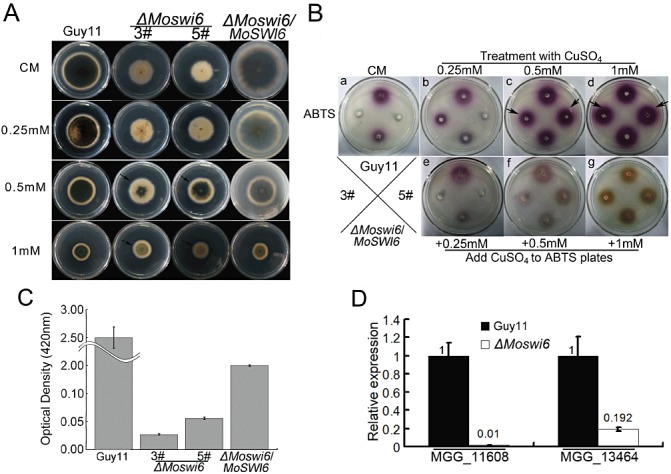Figure 4.

Laccase activity is reduced in ΔMoswi6 and can be restored by the addition of CuSO4. (A) After growth for 6 days with Cu2+ on complete medium (CM), melanin was restored to the ΔMoswi6 mutant, particularly on medium containing 0.5–1 mm CuSO4. (B) The Guy11 ΔMoswi6 mutants (#3 and #5) and the reconstituted (ΔMoswi6/MoSWI6) strains were incubated on a CM plate for 6 days (a) and then incubated on a 2,2′‐azino‐di‐3‐ethylbenzathiazoline‐6‐sulphonate (ABTS) (0.2 mm) plate (b–d). After a 6‐day treatment with 0.25, 0.5 or 1 mm CuSO4, respectively, the Guy11 ΔMoswi6 mutants (#3 and #5) and the reconstituted (ΔMoswi6/MoSWI6) strains were incubated on an ABTS plate (0.2 mm) for 24 h. (e–g) The Guy11 ΔMoswi6 mutants (#3 and #5) and the reconstituted (ΔMoswi6/MoSWI6) strains were incubated on CM for 6 days and then incubated on an ABTS plate (0.2 mm) supplemented with 0.25, 0.5 and 1 mm CuSO4 for 24 h. (C) Laccase activity absorption value at a wavelength of 420 nm. The laccase activity in the ΔMoswi6 (#3) mutant was reduced compared with that of the wild‐type Guy11. (D) Transcription of putative laccase genes in the ΔMoswi6 (#3) mutant and wild‐type Guy11. The relative abundance of the transcripts compared with the standard condition (wild‐type) is displayed as a number. Data represent three independent experiments, each performed three times.
